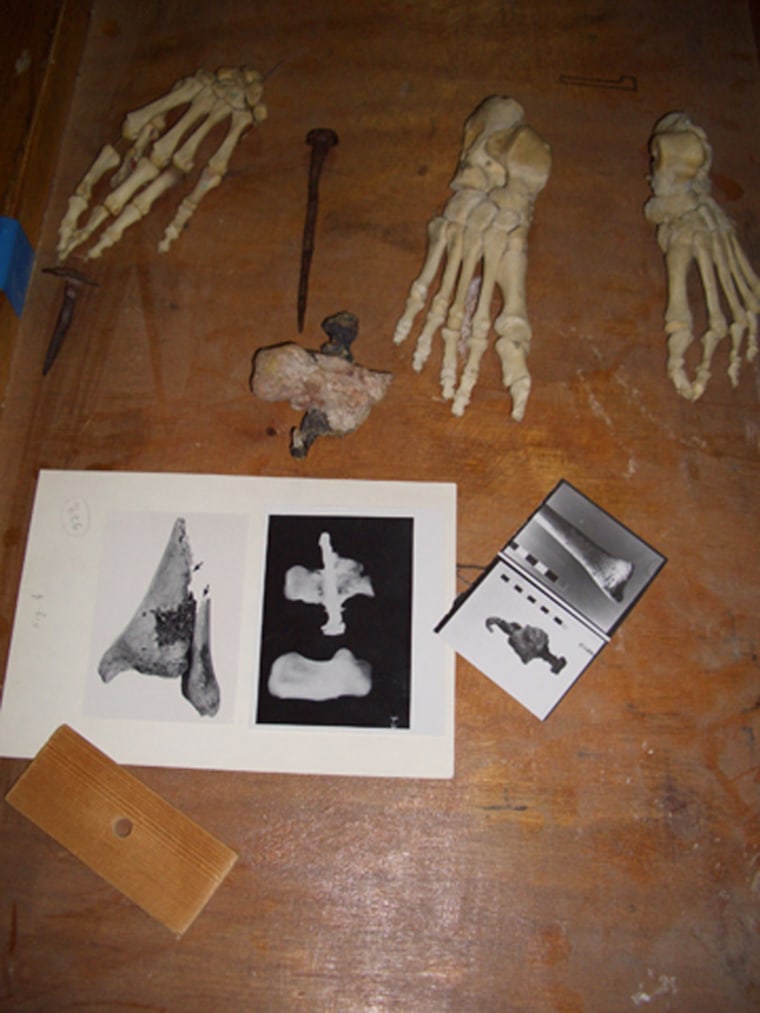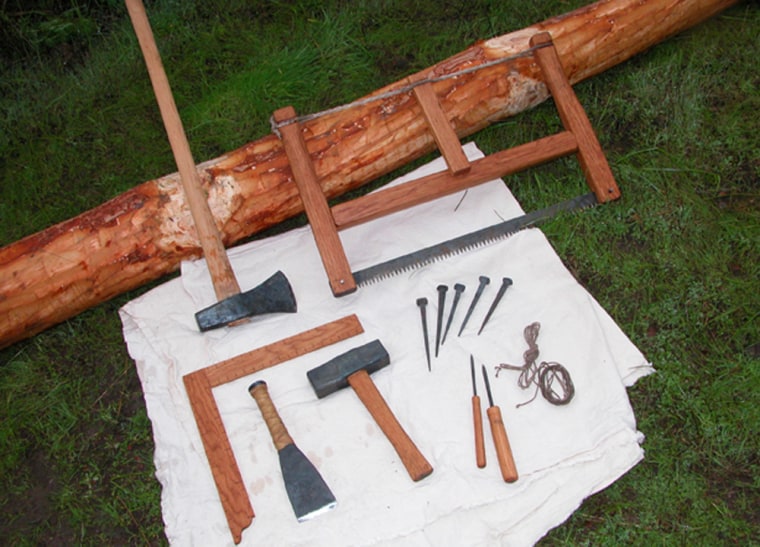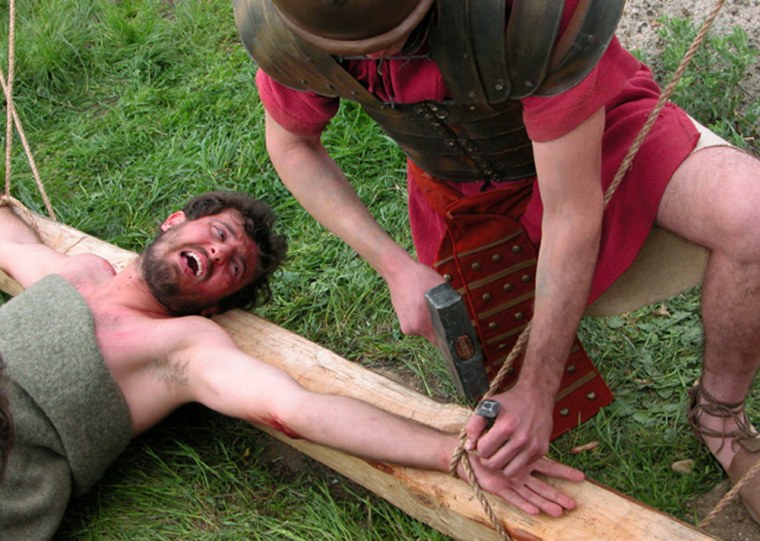Biblical archaeologist Jonathan Reed says he has undergone something of a conversion. Maybe that's what staging a crucifixion does to you.
For "Quest for Truth: The Crucifixion," a TV documentary premiering on Easter Sunday on the National Geographic Channel, Reed conducted an experiment with a volunteer tied to an actual cross. Reed even took a turn on it himself.
No one was actually hurt. The researchers stopped short of pounding nails into feet, and monitored their volunteer victims closely for any signs of stress. But Reed, a religion professor at the University of La Verne in California, said spending time on the cross was nevertheless a "dark" experience that gave him a new appreciation for Roman cruelty.
It also changed his mind on some of the central historical questions surrounding the practice. Going into the experiment, Reed fully believed that crucifixion victims couldn't have been nailed by the palms of the hands, and that they had to have died of asphyxiation. But now he thinks the Romans could well have targeted the palms to maximize their victims' agony, and that death was more likely due to heart failure, brought on by shock, pain and exposure.
"I tried to have an open mind and let the experiment guide me to a conclusion," he told MSNBC.com.
In addition to tracing Reed's experiment, National Geographic's "Quest for Truth" (9 p.m. ET/PT Sunday) reviews other archaeological and forensic studies that have been sparked by the biblical accounts of Jesus' crucifixion on Good Friday.
Archaeological mysteries
For Christians, the crucifixion represents the ultimate sacrifice, setting the stage for the mystery of Jesus' resurrection and humanity's redemption. For archaeologists, however, the phenomenon raises mysteries of a different, grislier sort.
How could Roman soldiers conduct hundreds of crucifixions in the course of a day, as recorded in 1st-century accounts? Did the cross match the pictures portrayed in artwork over the centuries? And if crucifixion was such a widely used instrument of terror in Roman times, why is there such scant evidence left behind?
University of Texas biblical scholar L. Michael White, who also participated in "Quest for Truth," has a sensible answer for that last puzzle: "Most people who would have been executed by crucifixion would not have had people who were concerned about them after death," he told MSNBC.com. Their remains would have been scattered, White said. In fact, that was all part of the terror. Based on the Gospels, Jesus was an exception, in that he was carefully entombed after being taken down from the cross.

Another exception was discovered in 1968, when construction workers came across a 1st-century funerary box inscribed with the name "Jehohanan." Inside, researchers found the man's bones — including a heel bone that had a curled nail sticking through it.
Apparently, the man had been crucified, with his heel nailed to the side of the cross. The nail probably hit a knot in the wood and couldn't be removed when Jehohanan was taken down, so it was buried right along with the bone.
The case of Jehohanan told archaeologists several things: The feet of crucifixion victims really were nailed to crosses, and the fact that the hand bones showed no similar signs of damage indicated that the victims' hands were not necessarily nailed.
Reed's experiment built on such findings, as well as the assumption that the Romans would have gone for maximum efficiency and maximum pain in conducting crucifixions. The re-creation of Jesus' crucifixion led Reed and his colleagues to conclude that the reality was almost certainly different from the portrayals in Renaissance masterworks.
The revised standard crucifixion
Like most archaeologists, Reed didn't try to use his experiment to "prove" the historical truth of the Gospels. Rather, Reed used the scriptural accounts as yet another resource for designing the experiment and solving the scientific puzzles.
"To try to begin to get the answers, you don't need to go to the library," he explained. "You need to go outdoors."
Reed and the "Quest for Truth" producers surveyed the Southern California countryside, looking for the trees that were most likely to be used for crosses. They settled upon a Jerusalem pine. Then, using ancient-style tools that a blacksmith created specially for the program, workers fashioned the pine into test crosses.
Working with the wood quickly confirmed the prevailing archaeological view that Jesus was crucified on a T-shaped cross rather than the now-conventional Latin cross — and that he carried only the horizontal beam, probably as a yoke with his hands tied to each end.
Why? It turns out that a full Latin cross would have weighed 380 pounds (173 kilograms), which the modern-day stand-in for Jesus found virtually impossible to lift, let alone carry. Even the horizontal beam was a trial, and the volunteer had to be relieved after walking only about a third of the course to his simulated Golgotha. In the Bible, a bystander named Simon of Cyrene was recruited to carry Jesus' cross.
Also, a Latin cross would have been excessively awkward to erect at the crucifixion site, requiring six strong men and a web of ropes. The Romans would have "come off looking less secure and less in charge," Reed said.

Using a T-cross, with a slot-and-tab arrangement at the top, would make it possible for just three men to raise a victim to execution.
"It not only matches the archaeological evidence, but it's just so easy," Reed said. Additional evidence comes from a 1st-century, anti-Christian graffito in Rome that shows a T-cross, and early Christian commentaries that criticize the Greek letter tau "because it reminds them of the crucifix," he said.
Although the case of Jehohanan showed that victims' feet were nailed, what about the hands? In the Gospel of John, the apostle Thomas refers to the nail holes in Jesus' hands. In the 1930s, experiments conducted with cadavers led researcher Pierre Barbet to conclude that nails driven through the palms of the hands could not have supported the weight of the arms and upper body —and that the nails were more likely driven through the wrists, which would have lent more support.
Crucifixologists also believed that the weight of the victim's body pulled down on the diaphragm, making it increasingly difficult for him to breathe and leading to death by asphyxiation.
A change of heart
More recently, however, researchers have come around to the view that the nailed feet provided enough support for the body, and that the hands could have been merely tied. "Quest for Truth" uses the Visible Human Project to show that putting nails through the palms would have resulted in maximum nerve damage and pain.
"The cruelty of the Romans would have led them to find the palms of the hands as the most painful part," Reed said. He suggested that the Romans also used wooden washers to make sure the hands and the feet couldn't be pulled away from the nails.
All that pain and exposure would have led to a condition called hypovolemic shock, based on tests that pathologist Frederick Zugibe conducted on student volunteers under closely monitored lab conditions. Blood pressure would drop, leading to irreversible organ damage, heart stoppage and death. Piercing Jesus' side would release the pooled blood and fluid, just as described in the Gospels.
The University of Texas' White said he considered the nailing of the feet to be the "crucial issue" for victims of the cross.
"That's the point of no return," he said. "It's not what kills him, but that's the death blow. ... Even assuming the person could have lived when you took him down from the cross, he never would have walked again."
Is this latest scenario for the crucifixion the scientific equivalent of the gospel truth? "At the present, I think we know what we can know," White said. But neither he nor Reed were willing to rule out the possibility that future finds might put a new perspective on the old texts.
"It's never finished," Reed said. "It's always open."
Onward to the Grail
For now, National Geographic's documentary team is moving on to other, less gruesome biblical themes — including the mystery at the heart of "The Da Vinci Code," the nature of the Holy Grail.
Reed was reluctant to tip his hand, but he said he already has an idea on how to approach the subject.
"Rather than looking to the myths that have grown up around the Holy Grail, I just look to archaeology, and what would have been the most common cup used by Jews in the 1st century," he said. "I think I'll just leave it at that."
An earlier version of this story incorrectly stated that Reed's experiment was conducted near Jerusalem.
